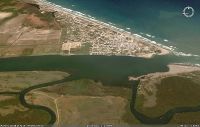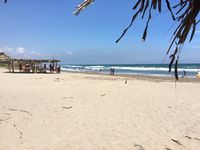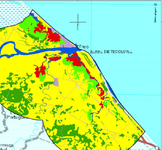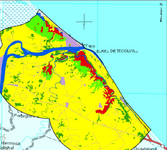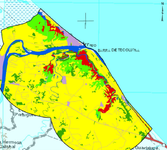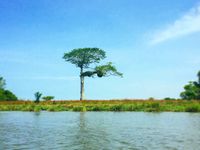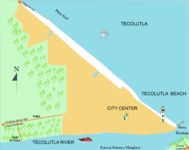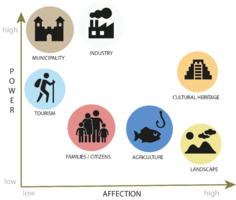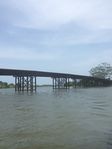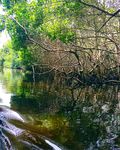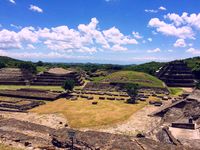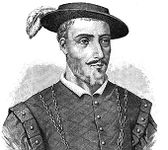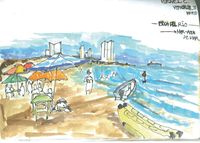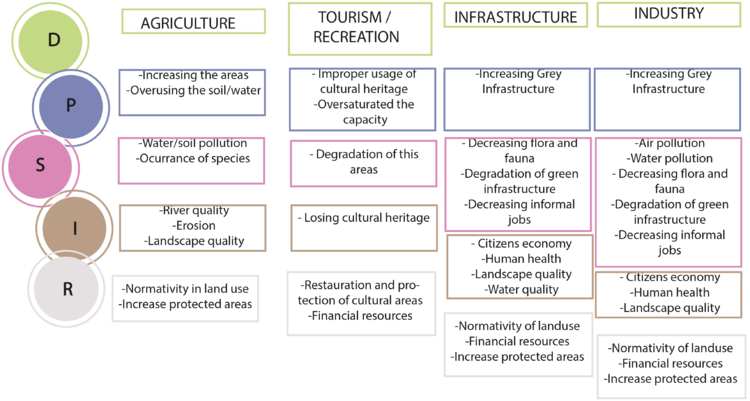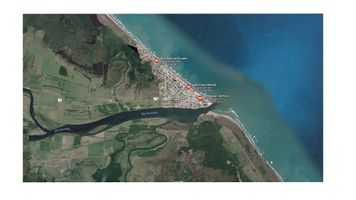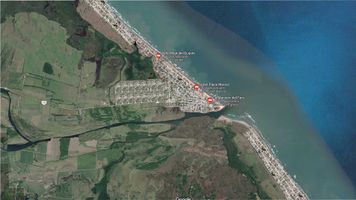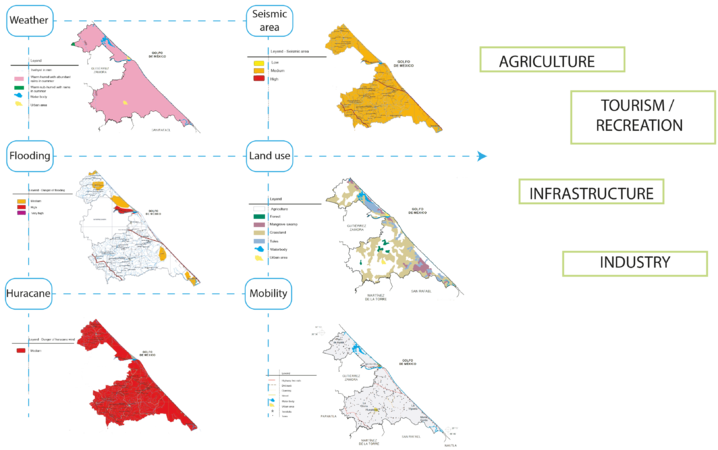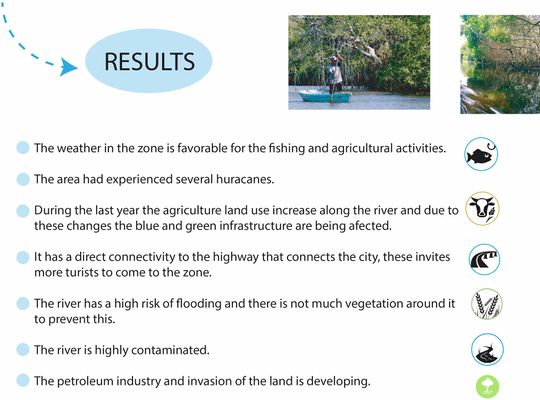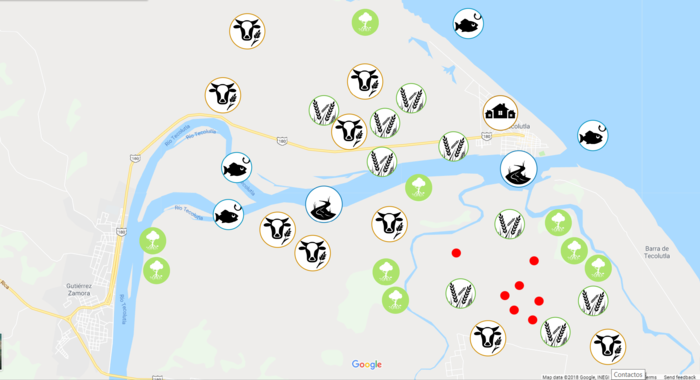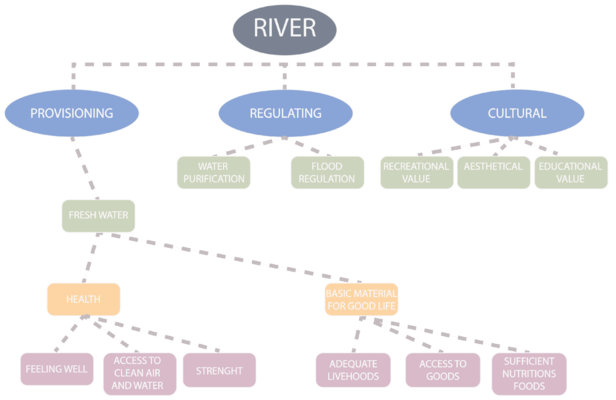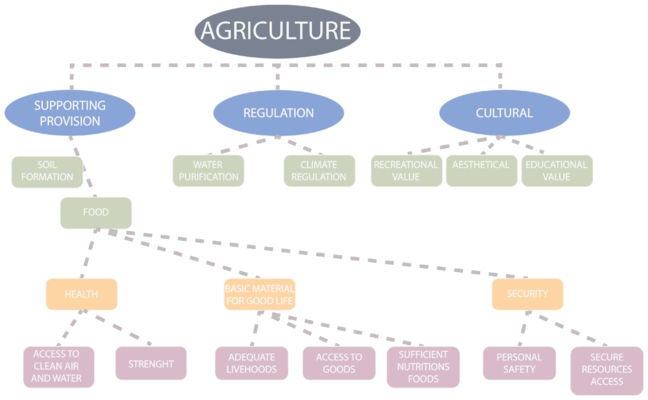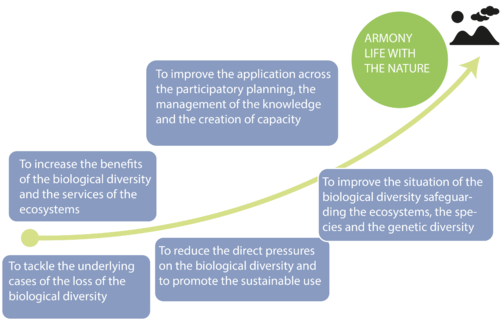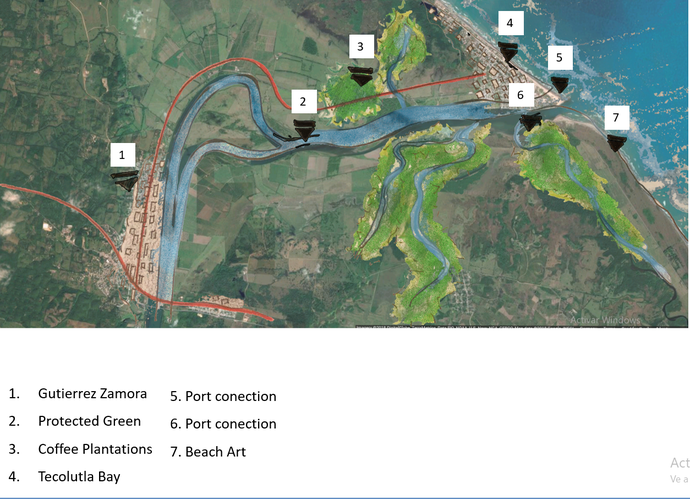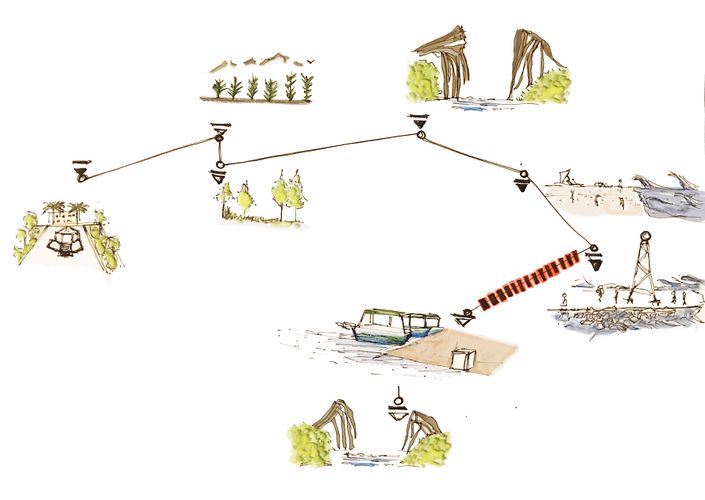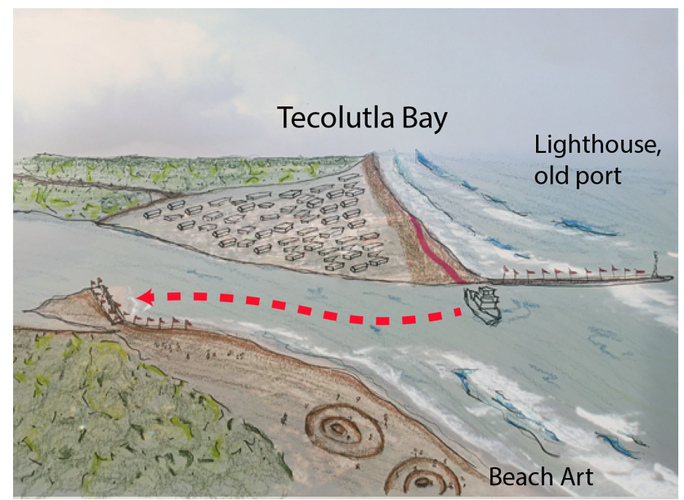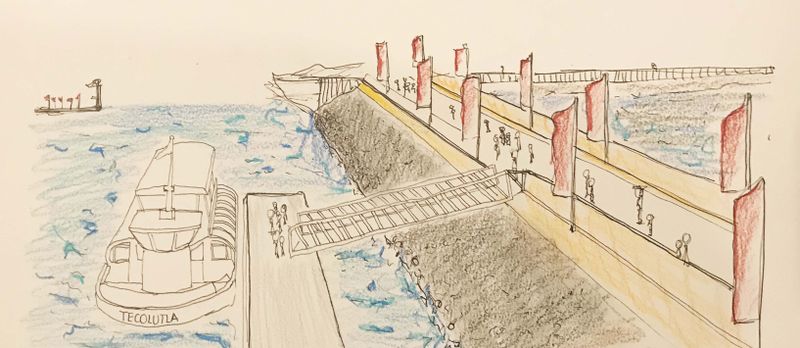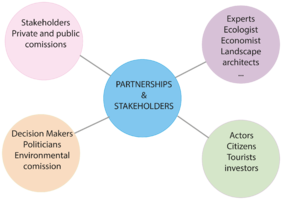Gulf of Mexico - Tecolutla
>>>back to working groups overview
| Area | Tecolutla Bay | |
| Place | Tecolutla | |
| Country | Mexico | |
| Topics | Tourism and nature protection | |
| Author(s) | Maythe Garcia Velarde | |
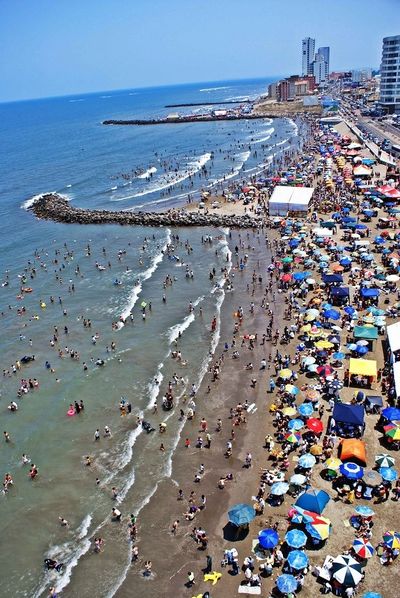
| ||
Rationale
Tecolutla Bay is one of the closest beach from Mexico City and much of its economy is based on tourism, as it is only a four or five hour drive from the capital. In the last years this area has been exploted in all its forms and capacities. The tourism, exploration of new oil wells, and agriculture are some of the main reasons that que quality of the place is decreasing.
Location and scope
You can edit this map with the map editor
A Landscape System Analysis
A.1 Landscape layers and their system context
Geomorphology, landscape units and coastal typology
The landscape is comprised of sandy flat beaches, estuaries, canals, small fishing bays and mangroves. Water pollution is common here, not only for the tourists, but also from the excessive agricultural activity along the Tecolutla river.
Land use
In the maps belows shows the changes during the years and different land uses in the coast of Tecolutla. The land uses are divided in: Infrastructure, Agriculture, Swamps, Other wetlands, Water bodies, Another Vegetation and Without Vegetation. During the years the state had change the land use for more agricultural activities. This is affecting the river, flora and fauna.
Green/blue infrastructure
For green infrastructure there are beaches, forest, meadows, agricultural lands, exotic birds, and some types of reptiles. The blue infrastructure are, rivers, streams, lakes, pounds and the sea gulf. Due to the increase of surfaces dedicated to human activities (agriculture and urban use), the amount or quality of green and blue infrastructure decreased or has been affected.
Actors and stakeholders
Tecolutla bay is one of the places where petroleum wells are located, now the Industry is investing more money to develop and make excavation around the area. But they are not thinking in the rural area, contamination of water and soil.This is making a problem with the fishermen of the area. The other one driver with high power is the municipality which is changing the land use all over the zone. The increase of agricultural fields is contaminating the river and decreasing the ammount of biodiversity in the area. The drivers who are most affected by these decitions are the landscape and the cultural heritage.
Sacred spaces and heritage
One element is the old structure pipes that were used in the past for the extraction of petroleum. 40 min away from the beach is located a protected area called "El Tajin", which is a archeological area with old ancient pyramids. These pyramids belong to the Totonaca culture. One of the elements that has cultural value at Tecolutla's bay is the river, which has mangroves that are protected by the people who is living there. This river is becoming a touristic attraction and the citizens created a tour in some part of the river. In this beach are located several camps dedicated to protect the sea turtle. This turtle is endangered, now a days tourists can go to these camps and they can liberate turtles.
- Which places/elements hold cultural value and to whom?
- You may add a map and some images, please also explain in your caption why these elements are valuable
Visual appearance and landscape narrative
The tecolutla river was dicovered by Juan de Guijalva in 1518, three years before the Spanish Conquest of the Aztec Empire. This caused violent confrontations between the Spanish and the local people at first but eventually led a mixing of culture between the natives and the European. The totonaca culture is the one who develop a city. Now a days a 6% of the population is Totonac. There exist some sketches of the beach, represnting the most emblematic elements along it.
A.2 Summary of you landscape system analysis and your development Targets
For the DPSIR. The main problems in the place are Agriculture, tourism, infrastructure and industry. The lack of normativity and lack of interest by the municipality to take care of natural places are making the degradation of the water and soil. The river is connecting the sea and contains a very important and sensitive area of meadows, which are protected by the communities. The tourism inside these sensitive areas without a control of damage can lead to an end of the river or change the ecosystem. The animals of the area can leave the place and emigrate to another zone. The touristic area is increasing such as the pollution of blue infrastructure. The local commerciants may leave or change their jobs to make another activities that can deal with industry. The cultural heritage of the place may change.
- You can summarize your findings with an DPSI(R) Model or a Spider Diagram
A.3 Theory reflection
For new solutions for the environmental crisis a new Earth Law is growing and developing. One of these is securing rights for nature would mean that rivers have a right to clean water and adequate flows, and ecosystems have a right to integral health free from pollution. For this exist World Conscious Pact, Derechos de la Madre Tierra (Rights of Mother Earth) of Mexico and Organi-K. The objective of this is to preserve the quality of the ecosystems.
Another legal paper for the rivers is a new Universal Declaration of River Rights. This paper includes: -The right to flow -The right to perform essential functions within its ecosystem -The right to be free from pollution -The right to feed and be fed by sustainable aquifers -The right to native biodiversity -The right to restoration.
By implementing these means the river will have a very strong identity and value for the people.
A.4 References
- give a full list of the references you have used for this section
-http://painanicollective.blogspot.de/2013/02/tecolutla.html -Comision Nacional para el Conocimiento y Uso de la Biodiversidad (CONABIO), 2013. https://www.biografiasyvidas.com/biografia/g/grijalva.htm http://grupoindigenatotonacos.blogspot.de/2015/04/1-significadodel-nombre.html http://urbansketchers-mexico.blogspot.de/2011/04/veracruz.html
Phase B: Landscape Evaluation and Assessment
B.1 Assessment Strategy
The goals of the assessment are, to identify the problems that the zone is dealing with. To locate the problems and to develop a strategy to restore, protect or maintain the zone.
The drivers of the area are: agriculture, industry, infrastructure and tourism. The elements that need to be mapped are: Agriculture, tourism activities in a the sensitive area and industry. This will help to know where the problem is located and try to find a solution to improve the place.
B.2 Mapping
The findings of the overlay method demostrated that the place has a lot of potential and the popularity for using the place increased.
The map of the activities that are along the river proves that the river play a very important roll to develop these activities.
B.3 Problem definition and priority setting
B.4 Theory reflection
- Please reflect the assessment and evaluation methods used based on at least three readings
- Did you encounter limitations'
- 200 words test contribution
Millennium Ecosystem Assessment, 2005. Ecosystem and Human Well-being Burkhard B et al., 2017.Mapping Ecosystem Services
B.5 References
- give a full list of the references you have used for this section
Phase C – Strategy and Master Plan
C.1 Goal Setting
The goals for this area are: -Clean river: in this place the river has a very powerful identity, which helps the tourist and citizens to feel attracted to interact and be very close to it. By having a clean river will help the flora and fauna to expand or not to be on risk of extintion. -Promote Sustainable use (Agriculture and Fishing): having a better treatment for the soil, animals and fields, will help the environment and as a result less soil contamination. -Participatory Planning (Including/Inviting/Informing citizens to the change): this helps to let the people know about the environment and how to take care of it. -Identify and tackle the problems that are harming the environment.
C.2 Spatial Strategy and Transect
- translate your strategic goals into a vision
- develop a spatial translation of your vision
- exemplify your vision in the form of a transect with concrete interventions
- add map(s) and visualizations
C.3 From Theory of Change to Implementation
- For implementing your vision: Which partnerships are needed? Which governance model is required?
- Who needs to act and how? Draw and explain a change/process model/timeline
- Which resources are needed? On which assets can you build?
- add 150 words text and visuals
C.4 References
- give a full list of the references you have used for this section
D. Process Reflection
Limitations -The location is far away -Lack of time -Lack of information from my site
- What would you do differently next time?
I would like to be in teams and have more time for this.
